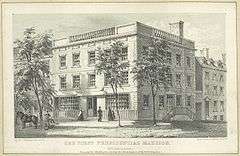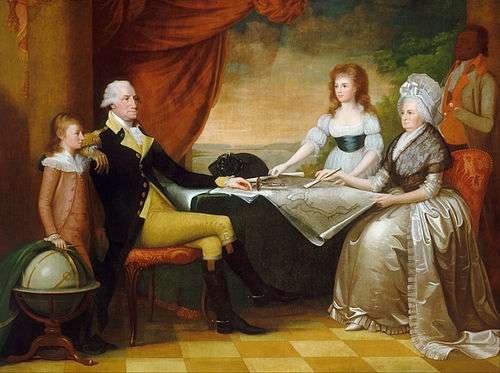Samuel Osgood House (New York City)
| Samuel Osgood House | |
|---|---|
 First Presidential Mansion, occupied by George Washington, April 1789 - February 1790 | |
| General information | |
| Address | 1 Cherry Street |
| Town or city | New York, New York |
| Country |
|
| Coordinates | 40°42′34.3″N 74°00′05.4″W / 40.709528°N 74.001500°WCoordinates: 40°42′34.3″N 74°00′05.4″W / 40.709528°N 74.001500°W |
| Construction started | 1770 |
| Demolished | 1856 |
| Client | Walter Franklin |
The Samuel Osgood House (demolished in 1856), also known as the Walter Franklin House, was an eighteenth-century mansion at the northeast corner of Pearl and Cherry Streets in Manhattan. It served as the first Presidential Mansion, housing George Washington, his family, and household staff, from April 23, 1789 to February 23, 1790, during New York City's two-year term as the national capital.
The owner, Samuel Osgood, was a Massachusetts politician and lawyer, who settled in New York City. He married Maria Bowne Franklin, widow of Walter Franklin, the merchant who had built the house in 1770.[1] Congress rented it for Washington's use, and the President-Elect moved in a week before his April 30, 1789 inauguration as first President of the United States. In addition to living quarters, the Osgood House contained the President's private office (the equivalent of the Oval Office) and the public business office (the equivalent of the West Wing), making it the first seat of the executive branch of the federal government.
The Samuel Osgood Papers, at the New York Historical Society, list purchases made to prepare the mansion for Washington occupancy.
"I went the morning before the General's arrival to look at it. The best of furniture in every room, and the greatest quantity of plate and china I ever saw; the whole of the first and second stories is papered and the floors covered with the richest kinds of Turkey and Wilton carpets. There is scarcely anything talked about now but General Washington and the Palace."[2]

Steward Samuel Fraunces, former owner of nearby Fraunces Tavern, managed a household staff of about 20: wage workers, indentured servants, and enslaved servants. Slavery was legal in New York, and Washington brought seven enslaved Africans from Mount Vernon to work in his presidential household: William Lee, Christopher Sheels, Giles, Paris, Austin, Moll, and Oney Judge.[3]
Two of Martha Washington's grandchildren were part of the First Family: Nelly Custis (b. 1779) and "Wash" Custis (b. 1781).[4]
Soon after his inauguration, Washington became seriously ill with a tumor on his thigh (possibly caused by anthrax poisoning). Cherry Street was cordoned off to prevent his being disturbed.[5]
The house was rented for one year at an annual rent of $845, but the president vacated it after ten months when a larger residence became available. Washington moved to the Alexander Macomb House at 39-41 Broadway, which he occupied from February 23 to August 30, 1790.
Under the July 1790 Residence Act, the national capital moved to Philadelphia, Pennsylvania for a 10-year period, while the permanent national capital was under construction in the District of Columbia.
The Osgood House was demolished in 1856.[6] A bronze plaque where Pearl Street crosses under the Brooklyn Bridge approach marks its location.[7]
See also
- Alexander Macomb House, second Presidential mansion
- Germantown White House, twice temporarily occupied by President Washington
- President's House (Philadelphia)
- The White House
References
- Decatur, Stephen, Jr., The Private Affairs of George Washington (1933).
- Hoffman, Henry B. "President Washington's Cherry Street Residence." The New-York Historical Society Quarterly Bulletin, vol. 23 (January 1939): 90-103.
- Miller, Agnes. "The Macomb House: Presidential Mansion." Michigan History, vol. 37 (December 1953): 373-384.
- Wharton, Anne H. "Washington's New York Residence in 1789." Lippincott's Monthly Magazine, vol. 43 (1889): 741-745.
- ↑ "A Historic Home Marked", The New York Times, May 2, 1899
- ↑ Sally Robinson to Kitty Wistar, 30 April 1789, from www.MountVernon.org
- ↑ Biographical sketches from www.ushistory.org
- ↑ George Washington Parke Custis later became the father-in-law to Robert E. Lee.
- ↑ "While his doctors debated what steps to take, Cherry Street was blocked to traffic to spare the president its distressing noise. Then suddenly, the growth abscessed and the doctor lanced and drained the lesion." John E. Ferling, The First of Men: A Life of George Washington (University of Tennessee Press, 1988), p. 378.
- ↑ ."A Piece of History Stands Hidden on Brooklyn Bridge", New York Sun, June 30, 2006
- ↑ "George Washington slept here?!", The Bowery Boys: New York History, January 7, 2008